by Paula D.
on October 12, 2020 10:34 am in Food
Besides a few visits to see my mother on Long Island and an excursion to Pennsylvania to pick up a birdbath, this past weekend was the first time I left Rockaway since the start of the pandemic.

Matt and I went to Coney Island on Friday. I haven’t been in many years. Luna Park was closed and we couldn’t catch part of a Cyclones game but the vibe was fun and animated nonetheless. Nathan’s was open as were a few other restaurants and bars with outdoor dining.
We walked from West 12th Street to Seagate and back. Coney Island now is how I feel Rockaway used to be. Rough around the edges, dark but quirky – like old gritty New York. And I love that.

On Steeplechase Pier there were a bunch of people dancing and singing, surrounded by Puerto Rican flags. They were also playing percussion over the records! It sounded good. People were fishing. It seems to be a great place to throw out a line. The pier reaches 333 yards into the Lower Bay – the body of water surrounding the Coney Island Boardwalk (south of the Narrows).
Speaking of the boardwalk, we couldn’t help talking about the wooden chevron boards on our long walk. While it has charm and history, it’s in need of much repair. I did a trip a few times in my open toe sandals! We also saw a jogger completely eat it and fall face down on the boards. Also, it’s not conducive to biking. There were just a few brave cyclists trying to navigate the uneven path. It’s a shame because that would be a great stretch of 2.7-miles to ride on. The boardwalk was built in 1923 and has needed ongoing refurbishments. There was severe damage during Hurricane Sandy as you probably recall. It makes me think that our concrete boardwalk was 100 percent the right way to go.
After our walk, we sat at a table outside one bar. I got a vodka cranberry. We watched the colorful passersby. A tall Russian guy, whose name we later learned is DJ George, parked a stroller carrying a large speaker in it right where we were sitting. He started playing vintage disco music, dancing strangely, and announcing his moniker loudly, stopping only briefly to get a beer from the bar. It was hilarious and great entertainment.
The next day I was back in Brooklyn. I had a dog birthday party. Buffy turned 18! My friends Lori and Mike, Buffy’s caretakers had the party at Mission Dolores ( 249 4th Ave, Brooklyn,) in Park Slope. Beforehand though, I met my good friend from college, Cece and her husband Mansoor in Prospect Park. I figured I was in her neighborhood, so why not. The park is so lovely. My friends said essentially they used Prospect Park as a refuge throughout quarantine, picnicking and biking.

Buffy’s Party was in an outdoor courtyard so it felt “COVID safe”. We had a bunch of laughs, a bunch of wine, and really, really good pizza from Smiley’s (323 7th Ave, Brooklyn).
It was so refreshing to be out and about in Brooklyn after all this time. Using so many outdoor spaces reminded me of the importance of NYC Parks and greenspace in our city. I’m looking forward to exploring more of the city in the off-season and reporting back to you.


In the beginning of the gardening season Greenthumb NYC donated seedlings to the Beach 91st Street Community Garden vegetables and other plants. I grabbed a cucumber and okra plant. Two foods I’ve never grown before.

I almost forgot I planted the okra. And then a few weeks ago it became recognizable. It produced three pods. I was pretty excited about that. After all, I didn’t do much too care for it besides watering. While this plant may look like a legume, it’s not. Okra is related to the hibiscus plant and cotton plant. It’s a fruit. It’s origins are disputed but it is thought to be from West Africa, Ethiopia or South Asia. Today okra is cultivated in tropical and temperate regions around the world.
Okra is a favorite ingredient in southern cooking, partially Creole food. I remember having some delicious dishes when I visited New Orleans a few years back. With mine, I simply sauteed it on the stove top with olive oil, salt, pepper and cayenne. It was a tasty snack!
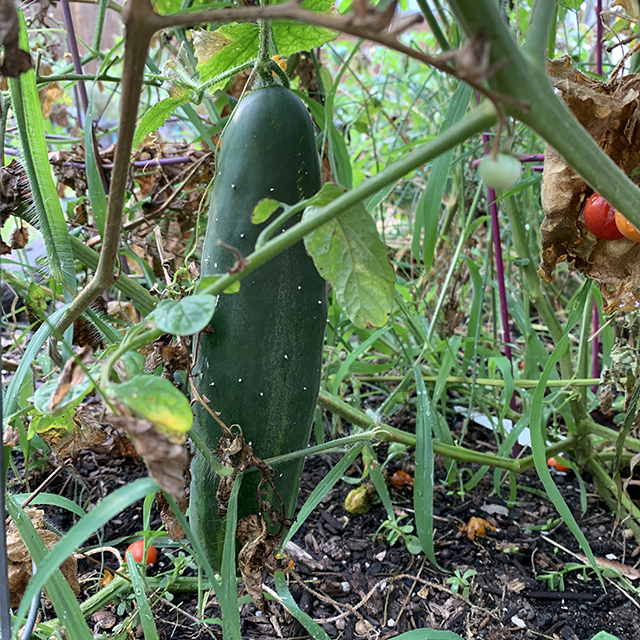
The cucumber plant was the big shocker. All season the plant produced very large cucumbers. As a garden geek, I couldn’t’ help document the sizes.The longest I grew was 11.5 inches! I will definitely be growing these again next season.
The identification tag was missing from the seedling plant when it was delivered by Greenthumb but I’m pretty sure I have slicing cucumbers. There are three main varieties of cucumber—slicing, pickling, and burpless/seedless. This is a creeping vine plant that needs to be trellised. They have spiraling tendrils. How do these specialized stems know to grab on? So fascinating.
I like making a tart cucumber salad with tomatoes, red vinegar and a half lemon. I add in a bit of shaved onions and season with salt, pepper and a healthy amount of oregano. Let it sit for at least an hour before you dig in.
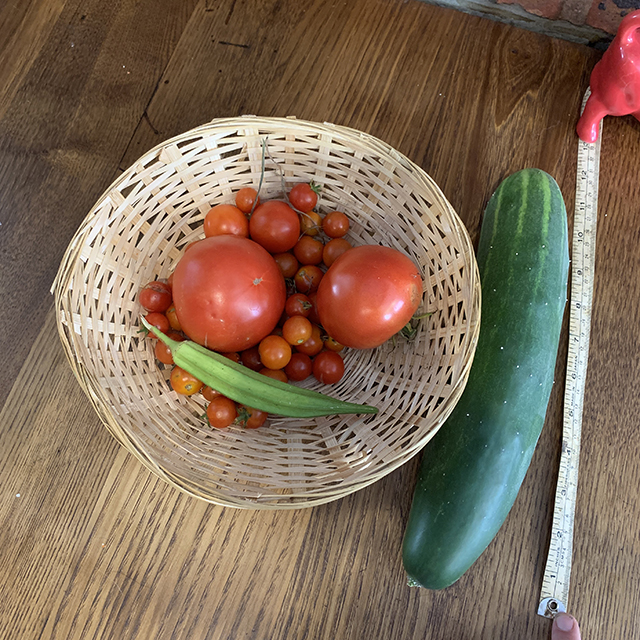
In writing this column, I learned that okra and cucumbers are considered companion plants. The flowers of the okra attract pollinators. Cucumbers require pollination to fruit. Cucumbers release nutrients into the soil that are beneficial to okra. And okra deters cucumber beetles. I was surprised that my cucumber plant did so well because in past years, we’ve had problems with squash beetles. I know for next year to plant okra as well for what seems to be a guaranteed healthy crop.
For more on gardening follow me on IG for the day to day – @theglorifiedtomato
by Paula D.
on September 14, 2020 2:59 pm in Food
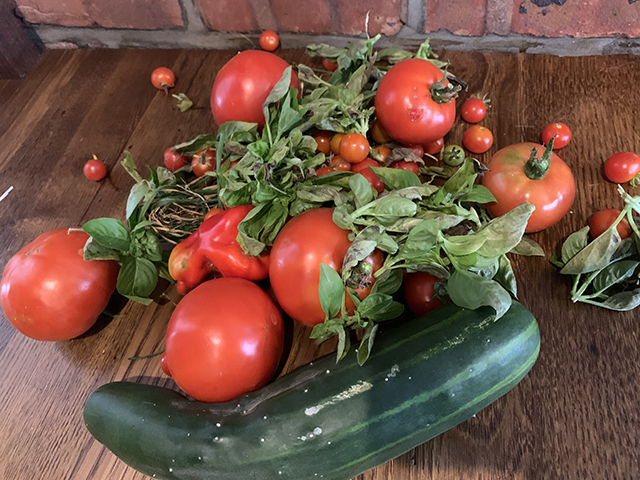
It would be completely inappropriate if I didn’t write about tomatoes before the end of the gardening season. I’m hoping all throughout August you’ve had an ample tomato harvest. Nothing compares to a sweet homegrown tomato.
The storm a few weeks back damaged some of my plants, but all things considered, I have a good crop. If we don’t get a cold spell or another big storm our plants will continue to produce throughout September. I planted a variety as always. This year there are some heirloom, beefsteak, cherry, and cocktail tomatoes. There are over 10,000 varieties of tomato. They come in a variety of colors including pink, purple, black, yellow and even white!
Also, the original Aztec name for tomato is xitomatl, which translates as “plump thing with a navel.” How adorable! And insane!
I’ve noticed my cherry tomatoes have been splitting and beefsteaks cracking. Every wonder what that’s from? Heavy rain, especially when preceded by dry weather, causes the fruit to crack and split. It most often occurs when tomatoes begin to ripen. So essentially, it’s when there is a dramatic change in the moisture level which causes tomatoes to expand faster than the skin can grow.
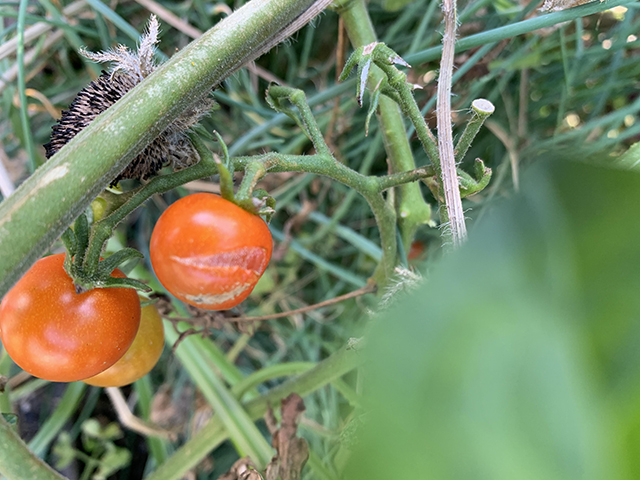
Soon after the tomato splits it will become insect food. If you’re seeing this problem, remove the fruit a little before it’s fully ripe. Better a tart tomato than none at all. Keep these tomatoes on your window sill. The sunshine will help them ripen naturally. And I remind you garden newbies, never put tomatoes in the refrigerator. The cool temperature changes the texture and taste, for the worse.
It’s been a good year as far as the absence of the tomato hornworm. At least speaking in the Beach 91st Street Community Garden. You’ll know them, if you see them. Those thick green worms, sometimes five inches long! They will blend into your tomato plant foliage and without removal, the worm will kill your whole crop. If you made it this far without the pest, then you’re free and clear. A tip: make sure you till your soil after this season in a couple of weeks to destroy overwintering larvae. Do this again in the spring. This is the best prevention.
I hope you’re making some delicious recipes with tomatoes this season. They are so versatile and flavorful. There’s nothing like the satisfaction of cooking with homegrown foods. If you have a unique tomato recipe I would love to hear about it.
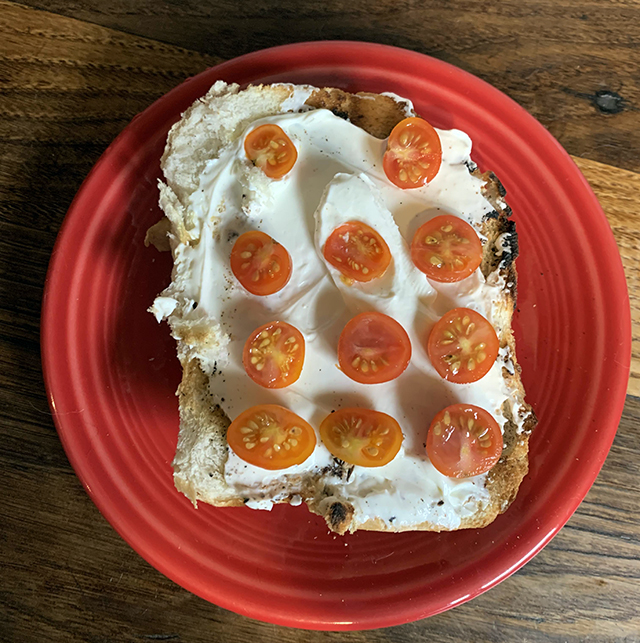
Simple sliced tomatoes with cream cheese on toasted bread with salt and pepper, so good.
For more on gardening follow me for the day-to-day on IG @theglorifiedtomato

Driving on the Belt Parkway over a decade ago, I remember seeing the landfill by Pennsylvania Avenue in Brooklyn. I recall the strange black netting over the garbage hills and the signs with Michael Bloomberg and Andrew Cuomo’s names on them, with an explanation of what was happening at the location. With the new administration, the signs changed to read Bill De Blasio, and architectural landscape plans were presented. But it seemed like it would forever look like an experimental nuclear site.
The former Fountain Ave. Landfill was in operation by the NYC Dept. of Sanitation from 1956-1983. It was deeded over to the National Park Service as part of Gateway National Recreation Area 1974. The initial massive restoration project to transform the land back into a viable ecosystem and public park cost $20 million dollars. The history of this site is extensive. If this sort of thing interests you, give this topic a google search.
On July 2, 2019 Shirley Chisholm State Park opened and since then, I’ve been wanting to visit. This past weekend I finally did.
Unprepared, I randomly pulled into the lot on the way home from picking up medication for one of the cats I’m fostering. I admired the vibrant painting of Shirley Chisholm on the side of the main entrance building. The painting is illustrated by Brooklyn muralist Danielle Mastrion.
A young guy at the booth offered me a map of the park. Out of the car and ready to go, I looked at the map and realized the park was expansive. It’s 407 acres, with 10 miles of bike trail. It towers 130 feet above sea level and has some of the highest ground in New York City – presenting panoramic views of the Empire State Building, The Verrazano Bridge and New York Harbor.
I wanted to tour the park on a bike to cover more ground. I headed in the direction of the Bike Library, where the rentals are located. I soon learned that reservations are most times needed. The bikes were all booked up. Not a big deal, I knew I was coming back again! If you want to reserve a bike, click here.

On my hike I read the park signage. The first being about Shirley Chisholm. The park is named after the late Brooklyn-born politician and educator who was the first African American Congresswoman, and the first woman and African American to run for President. Her accomplishments and contributions to our city and country are countless and inspiring.
As the trails continue other signage describes the ecosystem of Jamaica Bay and points out birds and other wildlife you may encounter during your visit. Besides walking and bike trails, the space offers picnic areas and fishing piers. Educational student tours and public tours are also available throughout the year.
I only managed to walk the trails by Penn Pier on the west side, the smaller section of the park. Next time, with a bike I’m ready to conquer the larger east side. My end goal being – bike from Rockaway to Shirley Chisholm State Park!
Shirley Chisholm State Park is located at 1750 Pennsylvania Avenue, Brooklyn, NY 11239 – (212) 866-310




































